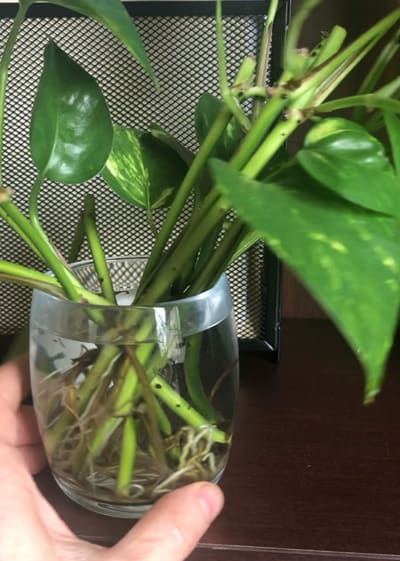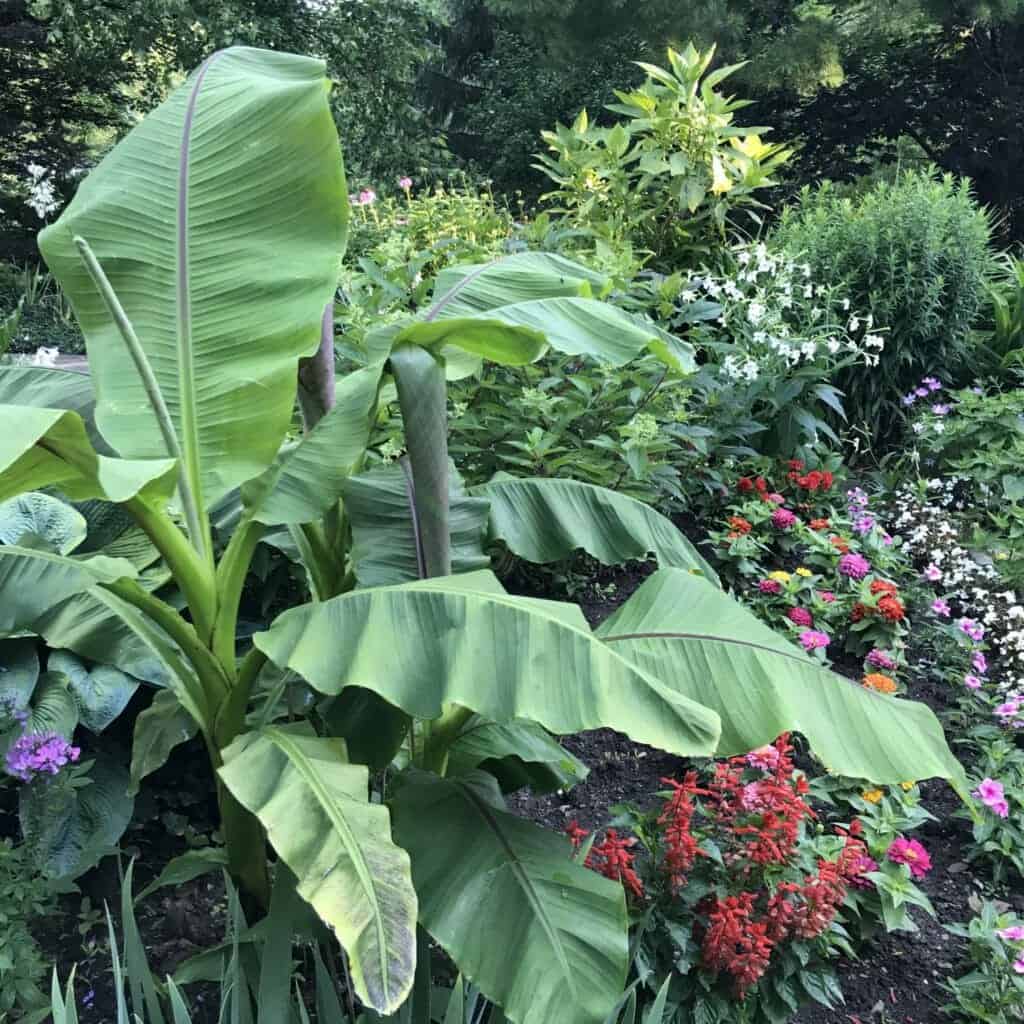Some of the links in this post may be affiliate links.
Growing Pothos is easy. This plant is EVERYWHERE. In shopping malls. In homes. In offices. Often times it is also one of the first houseplants that someone buys. To make things confusing though, Pothos goes by many names. Some people call it Pothos. Others call it Devil’s Ivy. If you really want to be correct, you will call it by its genus and species: Epipremnum aureum!
Keep reading and let me teach you what the optimal growing conditions are for Pothos, and also how you can easily propagate this easy-to-grow houseplant.

Regardless what you call it, it has many fantastic qualities and deserves to be part of ANY houseplant collection.
Keep reading and you will see how easy growing and propagating Pothos really is.
Table of Contents
POTHOS IN NATURE
It’s always a great idea to learn how and where plants grow in nature. It will give us some clues about how to care for them in our homes.
Pothos is native to the Solomon Islands. The climate averages around 27°C (about 81°F) with little change in temperature year round. How great is that?
The name of the genus, Epipremnum, tells us how it grows in nature. “Epi” is Greek for upon and “premnon” means trunk. These plants climb up trees and attach themselves with aerial roots.
Pothos will also ramble on the ground and serve as a ground cover. Unfortunately it has been introduced to many tropical areas and has become invasive.
For more fun details, check out my post on Pothos in the wild.
POTHOS CARE
1. LIGHT
In general, Pothos likes bright indirect light. They do not like too much sun. Avoid strong direct sun. In the home, a North or East exposure window works very well. Morning sun is perfectly fine.
If you choose to grow Pothos in West or South exposures, it may require any direct sun to be filtered so that the leaves don’t burn.
Part of the beauty of Pothos is that it is very tolerant of low light conditions. In fact, I’ve grown Pothos in an office with no windows before. It grew very well with just overhead lights!
Not to mention, it sat in complete darkness over each weekend!
There are very few plants that I would even consider growing away from a window. Pothos is one of them!
Be sure not to miss my blog post about plants to grow in windowless areas. Of course, even these plants will do better if they are in front of a window.
One thing to keep in mind is that if you grow Pothos in very low light, it will lose a lot of its variegation in the leaves. Instead, the leaves will turn more of a plain green color. The variegation is only pronounced when it has sufficient light.
2. TEMPERATURE
As far as temperatures requirements, Pothos are tropical plants and do best with warm temperatures of 70F (about 21C) and above.
Pothos tend not to do their best if they’re kept in a chilly room. If your room is on the chillier side, this may not be the best plant for that space.
I have a very large Pothos in my office at work and it does very well because it is warm and receives great lighting.
On the other hand, I once had a Pothos once in our sunroom that sulked because it was too cool. We hadn’t replaced our windows yet so the room would stay pretty chilly in the winter.
I moved the Pothos out of that room into a warmer bathroom. Not surprisingly, the Pothos finally started to thrive.
Many people underestimate the effect that temperature has on plants, so be aware!
3. WATERING TIPS
I will reiterate my general watering advice for houseplants as it applies to most plants. Pothos is no exception.
Wait until the surface of the soil is dry to the touch before watering again. At the same time, you don’t want to allow the soil to dry out completely.
If you’re looking for an amazing potting mix that you can use straight out of the bag for your Pothos, check out the Tropical Climber Soil Blend from Oh Happy Plants. This is an amazing mix and you will get 10% off at checkout automatically if you use my link.
I always water my houseplants deeply until water comes through the drainage hole at the bottom of the pot.
Be careful not to let your Pothos pot sit in water though because this will encourage root rot.
For general watering tips, read my blog post about common myths on watering houseplants.
4. FERTILIZING POTHOS
As a general rule of thumb for most houseplants, I will not fertilize in the winter when the days are short and there is little sun.
Then for the rest of the year, I fertilize with every watering. You read that correctly. Every watering. However, it is very dilute.
Read the instructions on whatever fertilizer that you use. If it isn’t formulated to be used at every watering, you will need to dilute it further so it’ll require some simple math.
There are other methods of fertilizing, but I prefer this method of frequent but dilute fertilization for growing Pothos and most of my other houseplants.
One benefit is that I don’t have to remember when I last fertilized since I do it every time! This also mimics nature. Plants in nature receive a slow and steady supply of nutrients and not a big slug of fertilizer at any one given time!
Here are some of my recommendations for fertilizers for Pothos and are available on Amazon:
Dyna-Gro Grow is my recommended all-purpose fertilizer for all tropical foliage plants. You can’t go wrong and is amazing stuff.
Osmocote would be a great choice if you just want to apply it once and forget about it for a few months! The granules are time-release so it has the same effect as using a liquid fertilizer dilutely every time you water, except these are round granules that you add to the soil and very slowly dissolve over time.
If you want the BEST fertilizer for your Pothos, and any other plant, I highly recommend Dyna Gro Grow. It is a complete fertilizer that has all the major macro and micronutrients, and is urea-free. I can’t believe the difference in the growth using this fertilizer!
For more information, check out my fertilizer blog post.
5. PROPAGATING POTHOS
POTHOS CUTTINGS

Pothos or Devil’s Ivy is one of the easiest houseplants to propagate. Simply take a cutting of the vine and place it in a jar of water until it roots. You can even see little brownish knobs along the vine.
These are the aerial roots that will start growing once you place them in water. In nature, these are the aerial roots that Pothos will use to attach onto tree trunks.
The point where the leaf and petiole (the “stem” that is attached to the leaf) is attached the vine is called a node. You will want one or two nodes to be in water. And make sure that each cutting that you make as at least one leaf, but two is better.
Take a look at this cutting that has rooted in water.

You can pot the cuttings into soil when the roots are an inch or two long. Don’t wait too long though otherwise your plant will become too accustomed to growing in water. Then it will have a harder time transitioning to growing in soil.
If you’ve had problems propagating Pothos and can’t seem to do it, I’ve written a blog post completely dedicated to this issue! Be sure to check out Pothos Not Rooting? Top 10 Secrets Why You’re Failing.
HYDROPONIC GROWING
If you want to grow pothos in water though, this is entirely possible! Really you can grow any plant in water. You do need a good fertilizer for best results though, otherwise your plant will grow excruciatingly slow.
I would recommend Dyna Gro Grow fertilizer if you want to grow pothos in water, and change the water weekly. In fact, this fertilizer is also recommended specifically for hydroponic culture!

TO HANG OR NOT TO HANG?
Pothos often times is sold in hanging baskets. I’ve certainly grown many Pothos this way. And it certainly makes sense given its rapid, trailing growth.
Another more interesting way to grow Pothos is to grow it as a floor plant with a moss pole. You can then tie the vines loosely against the moss pole as it grows.
By growing it this way, the plant will actually produce larger leaves than it would if it didn’t have a climbing support.
I converted the plant below from a hanging plant to a floor plant. I purchased a Mosser Totem Pole (available in various sizes on Amazon) and simply inserted it into the pot.
The specific one I used was a 42 inch pole, and these poles have the added benefit of being able to add on extenders as the plant grows.
All you have to do is soak the post before using it. Every morning, I like to use a mister to spray the post.
Take a look at the before and after!

MAKE YOUR OWN MOSS POLE
If you want to make your own moss pole, I’ve found that it is very easy to do! It requires minimal supplies, is easy and quick, cheaper than buying a pre-made one, and better quality!
Be sure to check out my printable, step-by-step, illustrated how-to blog post on making your own moss pole! You won’t believe how easy it is to make!
So there you have it! What more can you ask from a plant? Hopefully you have been armed with many tips on growing Pothos.
If you’re not sure whether you have a Pothos or Philodendron, check out my blog post that shows you 5 ways to tell the difference between a Pothos and a Philodendron. You will never get confused again!
POTHOS YELLOW LEAVES
There are numerous reasons why your Pothos may be getting yellow leaves.
Every time you let the soil completely dry out, the lower leaves on the Pothos vines will turn yellow and you will start to lose a lot of leaves.
Be aware of this. Pothos plants simply do not like to dry out completely! For more detailed information, check out my blog post on underwatered Pothos and what you can do to remedy the situation.
Another reason that your Pothos might be getting yellow leaves is from root rot. If your plant has been sitting in water for too long, or the soil has stay wet for too long (whatever the reason), root rot may be the cause.
Ironically, when plant have root rot, they exhibit many of the same symptoms of being dehydrated. This is because the roots have rotted and the plant can’t take in water from the soil anymore.
Another common reason for yellow leaves in Pothos is too much sun. These plants can grow in a variety of conditions. If they get a lot of direct sun, all of the leaves will turn a much lighter shade of yellow-ish green.
POTHOS TOXICITY
Pothos is toxic to cats and dogs because of calcium oxalate according to the ASPCA.
Pothos is easy to grow, grows quickly, and is easily propagated so you can share plants with your family and friends. Do you have any pothos? Comment below!







Darlene
Wednesday 1st of October 2025
How do I keep my pothos from fuzzy white bugs. I always find the white substance on the leaves whether they are inside or out doors
Raffaele Di Lallo
Thursday 2nd of October 2025
It sounds like you may have mealybugs. Check out my article here: https://www.ohiotropics.com/2023/11/14/how-to-treat-mealy-bugs-on-plants/
Kim K
Saturday 18th of January 2025
I love the Pothos plant. My oldest is from 1978, growing in my dorm room.
Pothos cuttings are fabulous in water. A globe shaped centerpiece from my daughters wedding has been growing roots and looking lovely since 2018!
I also enjoy three potted Pothos plants. I water them weekly. They need to fit on countertops, I need to be able to move them, so I will not re-pot them. They are in three very different sized pots. They are never fertilized.
Kimberly of Dayton, Ohio
Raffaele Di Lallo
Sunday 19th of January 2025
They really are some of the best houseplants ever!
tawna
Thursday 4th of March 2021
can you help me with a size of pot to choose? i notice the roots are completely bound in the pot i bought my pothos in. does this plant like that? if not, how much bigger should i go??? thanks
Raffaele
Thursday 4th of March 2021
It sounds like it needs a bigger pot. What diameter pot is it in now?
erica
Thursday 17th of October 2019
What an amazing and information filled blog. My plants and I are so happy we found you today :-)
Raffaele
Friday 18th of October 2019
I'm glad you enjoyed the blog post Erica! Thanks for taking the time to comment, and I have a lot more information on my blog so feel free to look around! Be sure to use the search feature if you're looking for something in specific! :-)
Starr
Sunday 27th of May 2018
I’m going to attempt your floor plant tips. Cross your fingers for me! And when you say you spray the moss, is that just at the start it always?
rcdilallo@gmail.com
Tuesday 29th of May 2018
I would spray it regularly.